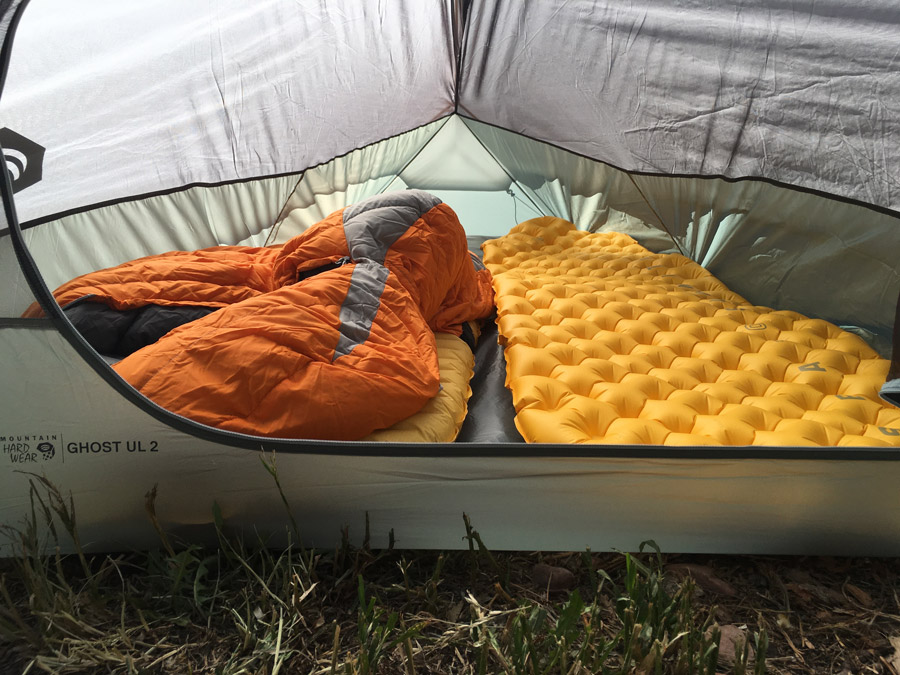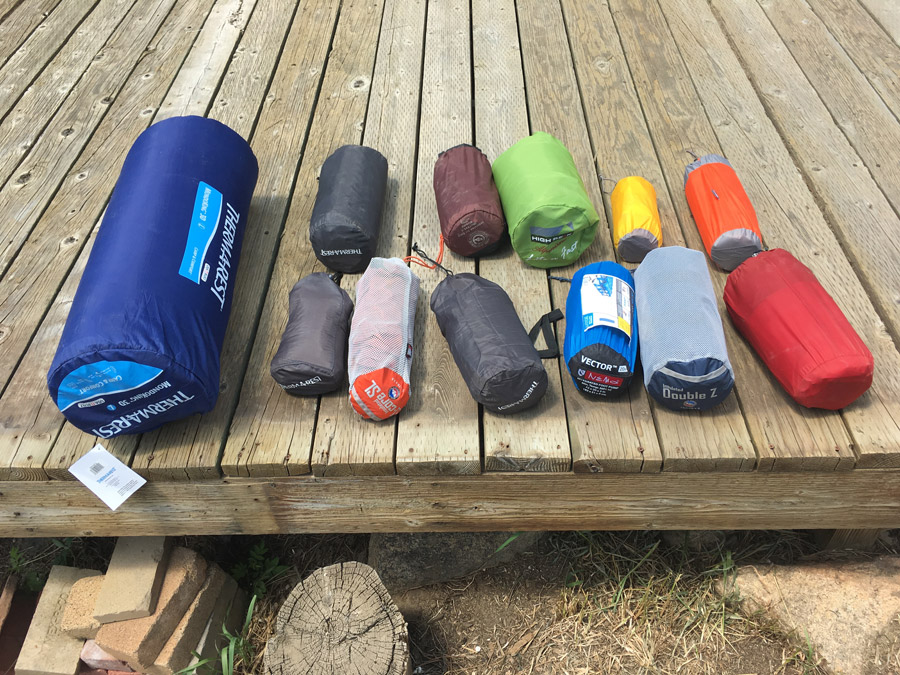



Whether sleeping in a tent, under the stars, or suspended in a hammock, a sleeping pad is an integral piece of gear to ensure that you stay warm, comfortable, and well-rested. Over the past few years, Active Junky testers have spent countless nights testing the best sleeping pads from top outdoor brands like Therm-a-Rest, Klymit, Big Agnes, and more. In this sleeping pads buyer's guide, which we updated in June 2020, you'll find our favorite sleeping pads, ranging from minimalist, lightweight pads for backpackers to cushy, comfortable pads that will have car campers snoozing through the night. Some are new pads that we tested this spring and summer, while others are tried-and-true pads that we've relied on for years.
Picking the right sleeping pad can be a daunting task, so we'll start by helping you narrow down your choices. But before we dive into how to pick a sleeping pad or the reviews themselves, we're going to break down a few of our favorite pads, just in case you know what you're looking for and want to get straight to the point. That said, regardless of what kind of sleeping pad you're shopping for, don't forget to sign up for Active Junky for exclusive deals and Cash Back on all of your gear purchases.

Photo: Aaron Bible
We instantly fell in love with Klymit's Klymaloft pad. The pad's hybrid air and foam design turns hard, uneven ground into 5-star comfort.
For winter camping and year-round use, the NeoAir XTherm is in a class of its own. The ultralight pad has an incredible warmth-to-weight ratio, and we've used this while winter camping in tents and snow caves and always stayed cozy.
When it comes to backpacking, we're fans of Therm-a-Rest's NeoAir XLite. The popular design is compact, comfortable, and reliable.
This pad isn't going to win any awards in the comfort category, but it outscores every inflatable pad when it comes to reliability and durability. It's also a must-have for winter camping.

Photo: Aaron Bible
Here are three simple questions to consider before deciding on a sleeping pad.
Backpackers worry about sleeping pad size and weight, but car campers are more concerned with comfort. This question will help determine the size and shape of your desired pad.
Are you a fairweather camper who only camps in summer? Look for uninsulated or lightly insulated pads (these will save space and weight in your pack, and are also much cheaper). If you camp year-round, you'll need more insulation. Insulated sleeping pads tend to be bulkier, but they will help ensure you have a comfortable night's sleep in lower temps.
Do you camp once a year, or head out on multi-day backpacking trips regularly? You don't need to invest in an expensive, premium pad if you camp infrequently. On the other hand, if you're planning on hiking the PCT, investment-grade is not a bad idea.
In the below reviews, we'll often discuss R-value, which is a measurement used to quantify insulation. For our purposes, all you need to know is this: lower values mean less insulation and worse performance in cold temperatures. R-values near 1 are best for summer use, R-values from 2 to 4 can be used from spring to fall, R-values from 4 to 6 can be considered all-season pads, and R-values over 6 are ready for serious winter camping. Check out this article from Therm-a-Rest if you want to delve deeper into the science behind R-values.

Klymit is undeniably an innovator in the sleeping pad space. We first tested Klymit's ultralight, skeleton-style sleeping pads many years ago—they modernized sleeping pads for backpackers, bikepackers, and anyone who prioritized pack volume over comfort. The brand has since branched out into tents and sleeping bags, both of which have impressed our test team, but its roots are undeniably in sleeping pads. Needless to say, we were excited to get our hands on Klymit's latest sleeping pad, the Klymaloft. While a far cry from the ultralight backpacking pads that first got Klymit on our radar, the Klymaloft is a hybrid foam and inflatable design that continues the brand's legacy of sleeping pad innovation.
Several testers dubbed the Klymaloft their car camping pad of choice. The foam topper, which runs two thirds down the length of the pad, is a brilliant feature. Outside of bringing a much heavier foam camping mattress, a full-on cot, or a Tempur-pedic mattress topper on your next camping trip, the Klymaloft is the best sleeping pad for comfort-seeking car campers (who occasionally go backpacking, too). It's only 2.5" thick, but don't worry—with the foam layer, testers found the Klymaloft incredibly plush and rated it more comfortable than inflatable competitors that were 3" and 4" thick. One tester purposefully laid the Klymaloft over a bed pinecones and snoozed soundly. Testers dug the ample width (23"), and several commented on how quiet the foam topper is when you're tossing and turning in your sleeping bag.
To be fair, Klymit might take offense at our calling the Klymaloft a "car camping pad." The brand did all they could to balance comfort and packed size (the foam topper is thin, and it doesn't run the entire length of the pad). That said, the Klymaloft does pack down better than most car-camping-specific pads (8" x 11.5"), and comfort-oriented backpackers can make the case that it's well worth the weight and pack space.
Due to the packed size, we'd only recommend taking this backpacking on shorter hikes due to the amount of pack volume it requires. 6-mile overnight? Ok, fine. Multi-day high-alpine loop? Not likely. Furthermore, with an R-Value of 2.1, it's not the warmest of sleeping pads. Lastly, because the integrated foam topper is covered with soft fabric, testers voiced potential concerns with odor management over time, especially when compared to standard inflatable designs. That said, we haven't stunk it up yet. Regardless, any cons are easily brushed aside by testers' overwhelming praise for the Klymaloft's comfort.
Bottom Line: Hands down our favorite car-camping pad for warmer three-season camping, the Klymaloft is unbelievably comfortable. So comfortable, in fact, that a couple of testers claimed that they were going to purchase one after taking the Klymaloft for a test run.
Best For: Car camping. Potentially mellow backpacking trips. Anyone who relates to the protagonist of the Princess and the Pea while sleeping outside.

The NeoAir XTherm continues to be our go-to pad for winter camping. The lightweight pad is quite compact—it's on par with standard inflatable pads when packed into its stuff sack—but Therm-a-Rest's compartmentalized core construction delivers a best-in-class warmth-to-weight ratio. Therm-a-Rest segmented the XTherm's internal structure into rows of triangles, which serve as a buffer between warm body and cold ground, helping to mitigate heat loss. For those who like to nerd out on numbers, the XTherm has an R-Value of 6.9 (Therm-a-Rest recommends an R-Value from 4 to 6 for all-season use, and notes that R-Values of 6 or higher are more suited to extreme cold). With a thickness of 2.5 inches, this Therm-a-Rest pad is exceptionally comfortable. The WingLock Valve is a welcome feature, too: the valve style enables quick, efficient inflation and deflation.
We haven't had any problems with the XTherm so far. If we're nitpicky, the internal core construction makes the pad crinkly and noisy when tossing and turning, but that's a small price to pay for the warmth it provides.
Bottom Line: The warmest and lightest pad we've ever tested for winter camping, simple as that.
Best For: Winter backpacking and camping. Year-round use for backpackers who want a single pad that can handle all weather conditions.

This popular pad is a three-season sleeping pad that changed the game when it came out, and the updated version remains our top pick for backpacking. Warm, compact, and comfortable, it's no surprise why so many diehard thru-hikers, backpackers, and alpine climbers swear by the Therm-a-Rest NeoAir XLite.
Size and weight, or the lack thereof, are huge pros of this Therm-a-Rest sleeping pad, especially when you consider that it boasts a high R-value of 4.2. The regular-sized NeoAir XLite packs down to approximately the size of a one-liter bottle and weighs a mere 12 ounces, meaning this is still one of lightest pads we've ever reviewed. Therm-a-Rest included reflective ThermaCapture technology to trap body heat and still keep weight down, but the real secret sauce is the Triangular Core Matrix, which segments the sleeping pad's internal structure into smaller chambers and amplifies the XLite's insulating properties.
Testers noted that this sleeping pad sports a small footprint, which is par for the course when it comes to ultralight sleeping pads. It's also a bit bouncy when fully inflated, and a lack of sidewalls makes it easier to slip off.
Bottom Line: This durable, warm, and lightweight pad was revolutionary when it came out, and the updated model is still a favorite for backpackers.
Best for: Fast and light backpacking, when every ounce counts.

It's no secret that we're fans of Therm-a-Rest's NeoAir series. The XLite is our top pick for backpacking, and the XTherm is our favorite pad for year-round use. Allow us to introduce the new NeoAir Topo Luxe, which is Therm-a-Rest's most plush backpacking pad. It's 4" thick, comfortable (provided you don't inflate it all the way), and still packs down relatively small (9.5" x 5.7", regular size). It also has a 3-season-ready R-Value of 3.7. If standard 2-2.5" inflatable pads don't do the trick for you, the Topo Luxe will likely deliver a better night's sleep.
One of our favorite features of the Topo Luxe is that it has two one-way nozzles. The deflation valve is easy to fiddle with in the dark, making it simple to let a little air out and get your support dialed just the way you like it.
We tested a regular pad, which is 20" wide. This width is standard for sleeping pads, but because the Topo Luxe stands so tall at 4", it actually feels quite narrow. For that reason, we recommend considering the wide version. Also, like all internally segmented NeoAir pads, the Topo Luxe is quite noisy.
Bottom Line: Calling the Topo Luxe the "most comfortable backpacking pad" or the "most compact car camping pad" is no stretch. It's light enough to take on longer backpacking adventures, warm enough for serious 3-season use, and comfortable no matter where you deploy it.
Best for: The Topo Luxe is a top pick for outdoor enthusiasts who both backpack and car camp and don't want to invest in a quiver of sleeping pads.

This Sierra Designs sleeping pad is a solid pick because of what it lacks—it's not heavy, and it doesn't come with a price tag that will make you wince. It's a simple, straightforward pad, with engineered baffles that help keep packed size down and inflate in a matter of seconds. At 14.5 ounces and a packed size of 10" x 3.5", the Shadow Mountain will speak to the fast, light, and thrifty.
The valve can be finicky. A tester thought she popped the pad, only to realize that the valve wasn't completely closed. Additionally, while the 3" pad is comfortable on even ground, testers noticed that rocks, sticks, and pinecones can jut between the baffles, causing discomfort. Lastly, the pad is uninsulated, which is reflected by a low R-value of 1.3.
Bottom Line: This pad is lightweight, packable, and affordable. It's not the most comfortable pad we tested, nor the most durable, but the price and the packed size make it a contender for backpackers.
Best for: Backpackers on a budget.

One of the lighter insulated backpacking pads on the market, the AXL delivers the backcountry comfort we expect from Big Agnes. Along the sides of the pad, baffles are 3.75", while inner baffles are 3.25"—this dish-like curvature helps to ensure that you stay centered on the pad and don't slide off onto the cold, hard ground. The ultralight weight (11.9 ounces, 20" x 72") and compact packed size (4" x 6.5") make the AXL hardly noticeable in your pack.
While we didn't have any immediate durability issues during testing, testers did voice concern about the ultrathin nylon material. Upon doing some research, we have read a handful of customer reviews on the AXL that cite leaks. Keeping that in mind, we are more inclined to recommend Big Agnes' durable, reliable, and comfortable Q-Core SLX, which has been one of our favorite sleeping pads for years.
Bottom Line: An ultralight option that, on paper, is a backpacker's dream sleeping pad. However, seam reliability seems to be a problem.
Best for: People who value lightweight gear above all else.

The Big Agnes Insulated Q-Core SLX is an improved model in which the brand increased insulation and padding while still maintaining a compact and lightweight camping pad. The insulation makes it a top performer for all three seasons.
This Big Agnes camp pad provides plenty of cushioning. Testers noted that the quilted construction offered more comfort than typical baffles. Synthetic insulation offers significant warmth without adding too much weight or bulk—the regular length weighs in at just over a pound. Our favorite aspect of the Q-Core, however, is its reliability. We’ve been using and abusing this pad for years and it’s never failed on us.
It's less compact than some of its competitors.
Bottom Line: We've tested this pad over the last several years, and Big Agnes Q-Core SLX is warm, comfortable, compact, and reliable. Synthetic insulation allows for comfort at lower temperatures.
Best for: Three-season camping and backpacking.

Sea to Summit's UltraLight Mat has been on the market for a few years, and it's still a top choice for minimalist backpackers.
The UltraLight Mat weighs in at under 14 ounces and packs down smaller than the size of a soda can. If you're an ultralight backpacker, the appeal is obvious. The Air Sprung Cell design offers unexpected support, and the one-way valve is intuitive and effective. One tester reported zero issues packing this lightweight sleeping pad back down to its original size.
Don't expect this pad to keep you warm. With an R-Value of 1, this pad is best used on summer nights.\
Bottom Line: One of the lightest and most compact sleeping pads you're going to find on the market at this low price point.
Best for: Light and fastpacking, minimalist trekking, summer camping and hammocking.

Klymit's Insulated Static V Luxe impressed Active Junky testers with the comfort it provided in lower temps, thanks to an ergonomic body-mapping design and V channels which limit heat loss. A burly albeit bulkier sleeping pad, the Insulated Static V Luxe will keep campers toasty.
Synthetic insulation gives this pad a 4.4 R-value rating, allowing the Insulated Static V Luxe to function as a four-season sleeping pad in temperatures below freezing (although in a serious winter camping scenario you'll likely want a closed cell foam pad beneath it). Oversized rails help keep you in place, as does the chamber design that provides further stability. Double valves make for quick inflation and deflation.
At 35 ounces, many backpackers will want to avoid this camp pad. Additionally, while the pad inflated quickly, it was difficult to fold back up to its original packed size.
Bottom Line: This Klymit pad may be overkill for summer, but for cold-weather camping on a budget, the Insulated Static V Luxe is a great choice.
Best for: Four-season camping when the need for insulation and warmth outweighs ounces.
With lightweight and rugged 30D polyester on top and 75D on the bottom, this is a durable camp pad that won't weigh down your backpack. Klymit’s body-mapping and V-chamber design make the Static V2 incredibly comfortable, especially considering the weight and the price.
Weighing 16 ounces and costing just $65, the Static V2 is all about saving pack space, weight, and money. Klymit's V-chambers maximize comfort and support while side rails keep your body from sliding off the pad. The Static V2 quickly inflates with about 15 breaths, and the valve system opens and closes without air loss.
The Static V2 scores an R-Value of 1.3, meaning that this pad is best for backpacking and camping in warm weather.
Bottom Line: If weight and price are deciding factors, the Static V2 is a great pick. It's a compact and durable backcountry companion.
Best for: Light, fast, and cheap summer backpacking and camping.

While inflatable pads have turned many away from closed-cell foam pads, these underappreciated, low-tech pads are incredibly useful all year round. Unlike inflatable pads, foam pads can’t pop or puncture. There’s no room for user error—you simply unfurl the pad and hit the hay.
In winter, we love to bring a pad like the Ridge Rest along for a few reasons. First, at night, we put the Ridge Rest on the floor of our tent or snow cave, and then add a NeoAir XTherm on top—this extra insulation makes a huge difference in overall warmth. Second, the Ridge Rest is a solid backup plan should your inflatable pad fail—you won’t be comfortable sleeping solely on the Ridge Rest, but you will (probably) make it through the night. Lastly, when you’re winter camping, there’s nowhere to sit comfortably. You know, because there's snow... Everywhere. When you’re hanging out around the tent or tending to the stove in your snow kitchen, sitting on a Ridge Rest pad is a smart way to stay warm and avoid contact with the snow.
Closed-cell pads are bulky and not as insulating as high-quality inflatable pads, but they’re definitely worth bringing along for the ride.
Bottom Line: When reliability trumps comfort, this budget pick is the smartest decision you could possibly make. It’s the only pad in this buyer’s guide that we can guarantee will never leak.
Best For: Budget camping or backpacking. International travel where a punctured sleeping pad would be a huge bummer. Multi-use scenarios when camping in the snow.